COIT20253 - Big Data for Fraud Detection in Banking Sector Analysis
VerifiedAdded on 2023/06/13
|15
|3716
|171
Report
AI Summary
This report explores the application of big data and big data analytics in fraud detection within the banking sector. It discusses data collection systems, storage requirements, and actions to be taken on collected data from the perspective of both existing and new customers. The report covers data mining techniques used for customer retention, credit card approval, fraud detection, marketing, and risk management. It also details storage solutions, including disaster recovery systems, and examines consumer-centric product design using customer relationship management (CRM) systems. Furthermore, the report investigates the use of recommendation systems to provide information to customers and concludes with a discussion on business continuity plans in the event of disruptions, emphasizing the importance of implementing big data analytics with proper requirements in the banking sector.
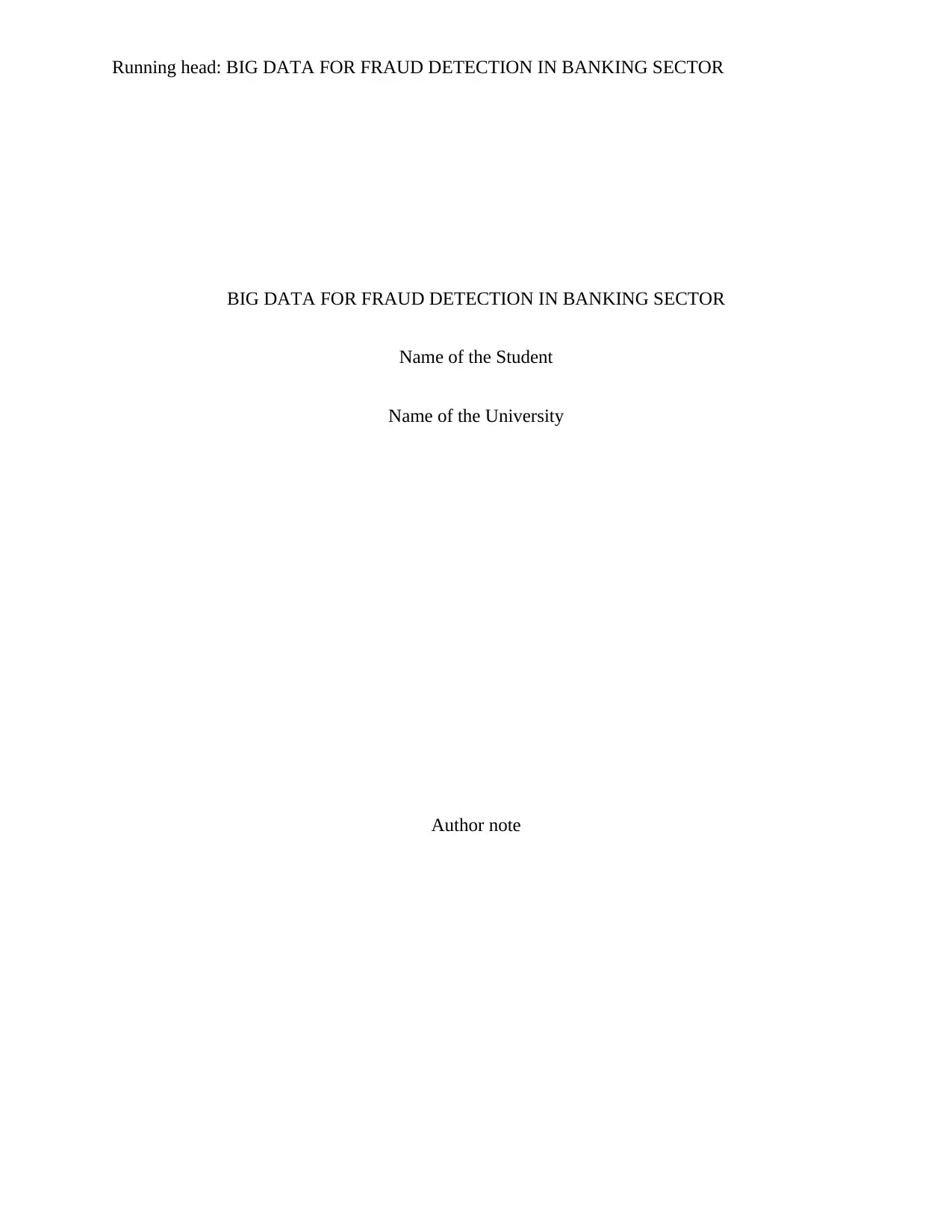
Running head: BIG DATA FOR FRAUD DETECTION IN BANKING SECTOR
BIG DATA FOR FRAUD DETECTION IN BANKING SECTOR
Name of the Student
Name of the University
Author note
BIG DATA FOR FRAUD DETECTION IN BANKING SECTOR
Name of the Student
Name of the University
Author note
Paraphrase This Document
Need a fresh take? Get an instant paraphrase of this document with our AI Paraphraser
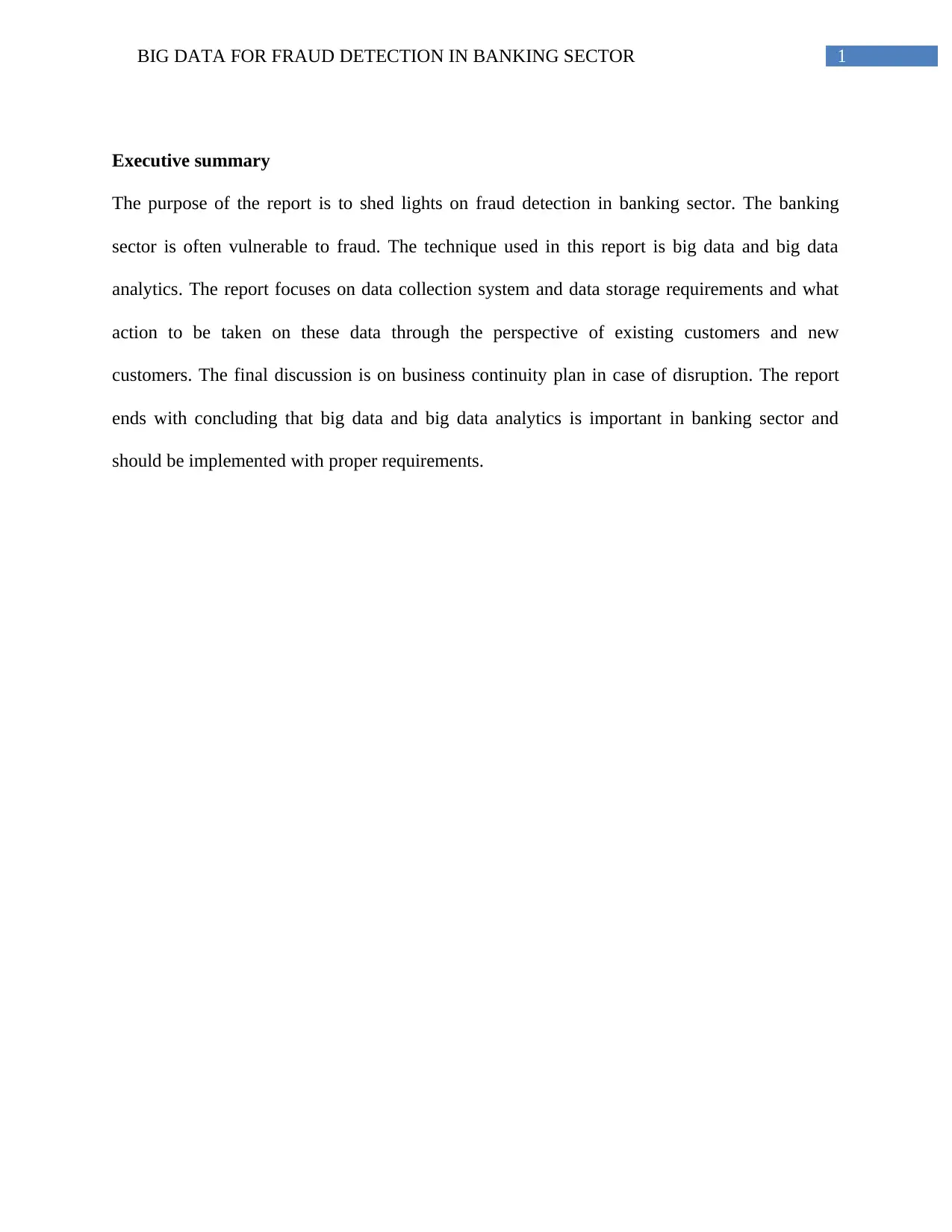
1BIG DATA FOR FRAUD DETECTION IN BANKING SECTOR
Executive summary
The purpose of the report is to shed lights on fraud detection in banking sector. The banking
sector is often vulnerable to fraud. The technique used in this report is big data and big data
analytics. The report focuses on data collection system and data storage requirements and what
action to be taken on these data through the perspective of existing customers and new
customers. The final discussion is on business continuity plan in case of disruption. The report
ends with concluding that big data and big data analytics is important in banking sector and
should be implemented with proper requirements.
Executive summary
The purpose of the report is to shed lights on fraud detection in banking sector. The banking
sector is often vulnerable to fraud. The technique used in this report is big data and big data
analytics. The report focuses on data collection system and data storage requirements and what
action to be taken on these data through the perspective of existing customers and new
customers. The final discussion is on business continuity plan in case of disruption. The report
ends with concluding that big data and big data analytics is important in banking sector and
should be implemented with proper requirements.
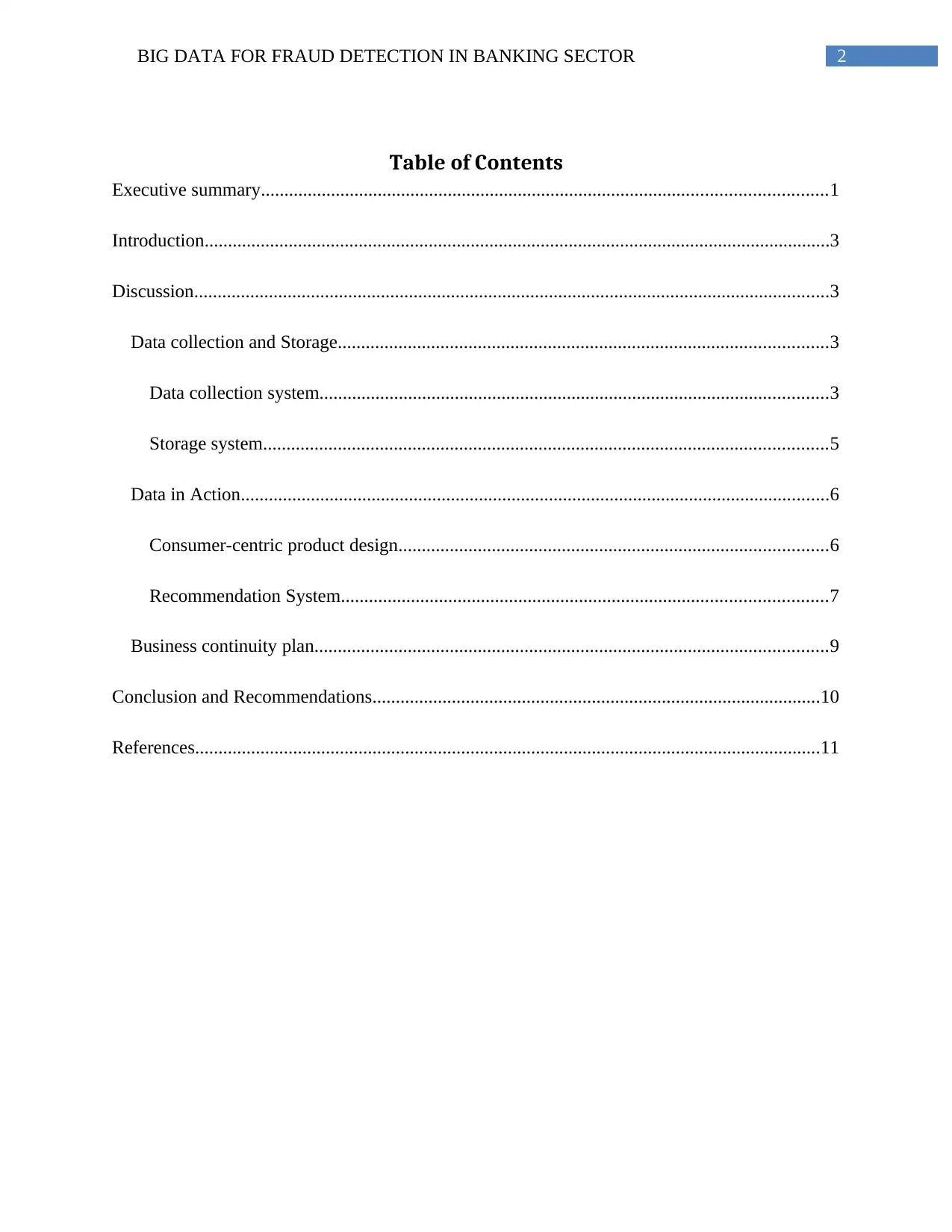
2BIG DATA FOR FRAUD DETECTION IN BANKING SECTOR
Table of Contents
Executive summary.........................................................................................................................1
Introduction......................................................................................................................................3
Discussion........................................................................................................................................3
Data collection and Storage.........................................................................................................3
Data collection system.............................................................................................................3
Storage system.........................................................................................................................5
Data in Action..............................................................................................................................6
Consumer-centric product design............................................................................................6
Recommendation System........................................................................................................7
Business continuity plan..............................................................................................................9
Conclusion and Recommendations................................................................................................10
References......................................................................................................................................11
Table of Contents
Executive summary.........................................................................................................................1
Introduction......................................................................................................................................3
Discussion........................................................................................................................................3
Data collection and Storage.........................................................................................................3
Data collection system.............................................................................................................3
Storage system.........................................................................................................................5
Data in Action..............................................................................................................................6
Consumer-centric product design............................................................................................6
Recommendation System........................................................................................................7
Business continuity plan..............................................................................................................9
Conclusion and Recommendations................................................................................................10
References......................................................................................................................................11
⊘ This is a preview!⊘
Do you want full access?
Subscribe today to unlock all pages.

Trusted by 1+ million students worldwide
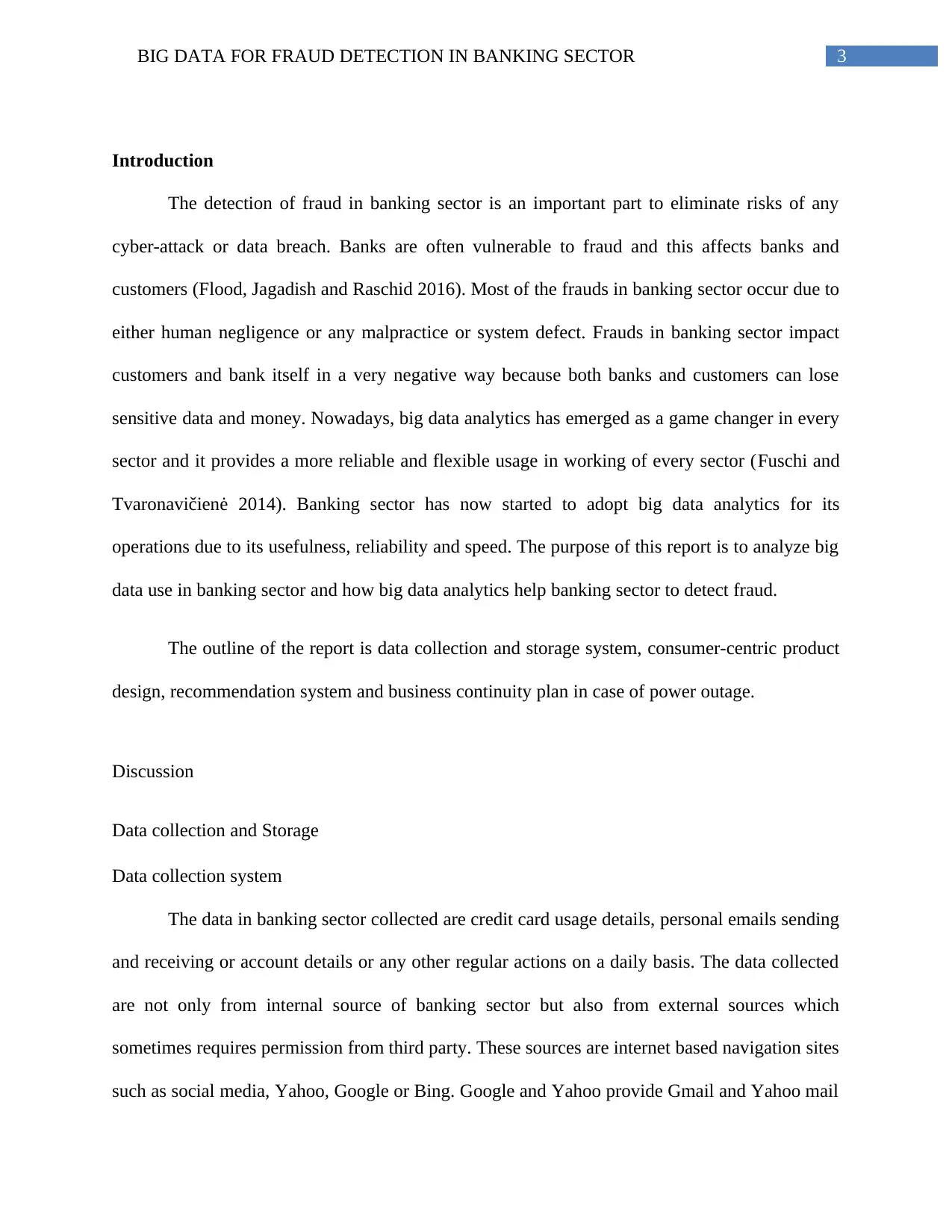
3BIG DATA FOR FRAUD DETECTION IN BANKING SECTOR
Introduction
The detection of fraud in banking sector is an important part to eliminate risks of any
cyber-attack or data breach. Banks are often vulnerable to fraud and this affects banks and
customers (Flood, Jagadish and Raschid 2016). Most of the frauds in banking sector occur due to
either human negligence or any malpractice or system defect. Frauds in banking sector impact
customers and bank itself in a very negative way because both banks and customers can lose
sensitive data and money. Nowadays, big data analytics has emerged as a game changer in every
sector and it provides a more reliable and flexible usage in working of every sector (Fuschi and
Tvaronavičienė 2014). Banking sector has now started to adopt big data analytics for its
operations due to its usefulness, reliability and speed. The purpose of this report is to analyze big
data use in banking sector and how big data analytics help banking sector to detect fraud.
The outline of the report is data collection and storage system, consumer-centric product
design, recommendation system and business continuity plan in case of power outage.
Discussion
Data collection and Storage
Data collection system
The data in banking sector collected are credit card usage details, personal emails sending
and receiving or account details or any other regular actions on a daily basis. The data collected
are not only from internal source of banking sector but also from external sources which
sometimes requires permission from third party. These sources are internet based navigation sites
such as social media, Yahoo, Google or Bing. Google and Yahoo provide Gmail and Yahoo mail
Introduction
The detection of fraud in banking sector is an important part to eliminate risks of any
cyber-attack or data breach. Banks are often vulnerable to fraud and this affects banks and
customers (Flood, Jagadish and Raschid 2016). Most of the frauds in banking sector occur due to
either human negligence or any malpractice or system defect. Frauds in banking sector impact
customers and bank itself in a very negative way because both banks and customers can lose
sensitive data and money. Nowadays, big data analytics has emerged as a game changer in every
sector and it provides a more reliable and flexible usage in working of every sector (Fuschi and
Tvaronavičienė 2014). Banking sector has now started to adopt big data analytics for its
operations due to its usefulness, reliability and speed. The purpose of this report is to analyze big
data use in banking sector and how big data analytics help banking sector to detect fraud.
The outline of the report is data collection and storage system, consumer-centric product
design, recommendation system and business continuity plan in case of power outage.
Discussion
Data collection and Storage
Data collection system
The data in banking sector collected are credit card usage details, personal emails sending
and receiving or account details or any other regular actions on a daily basis. The data collected
are not only from internal source of banking sector but also from external sources which
sometimes requires permission from third party. These sources are internet based navigation sites
such as social media, Yahoo, Google or Bing. Google and Yahoo provide Gmail and Yahoo mail
Paraphrase This Document
Need a fresh take? Get an instant paraphrase of this document with our AI Paraphraser
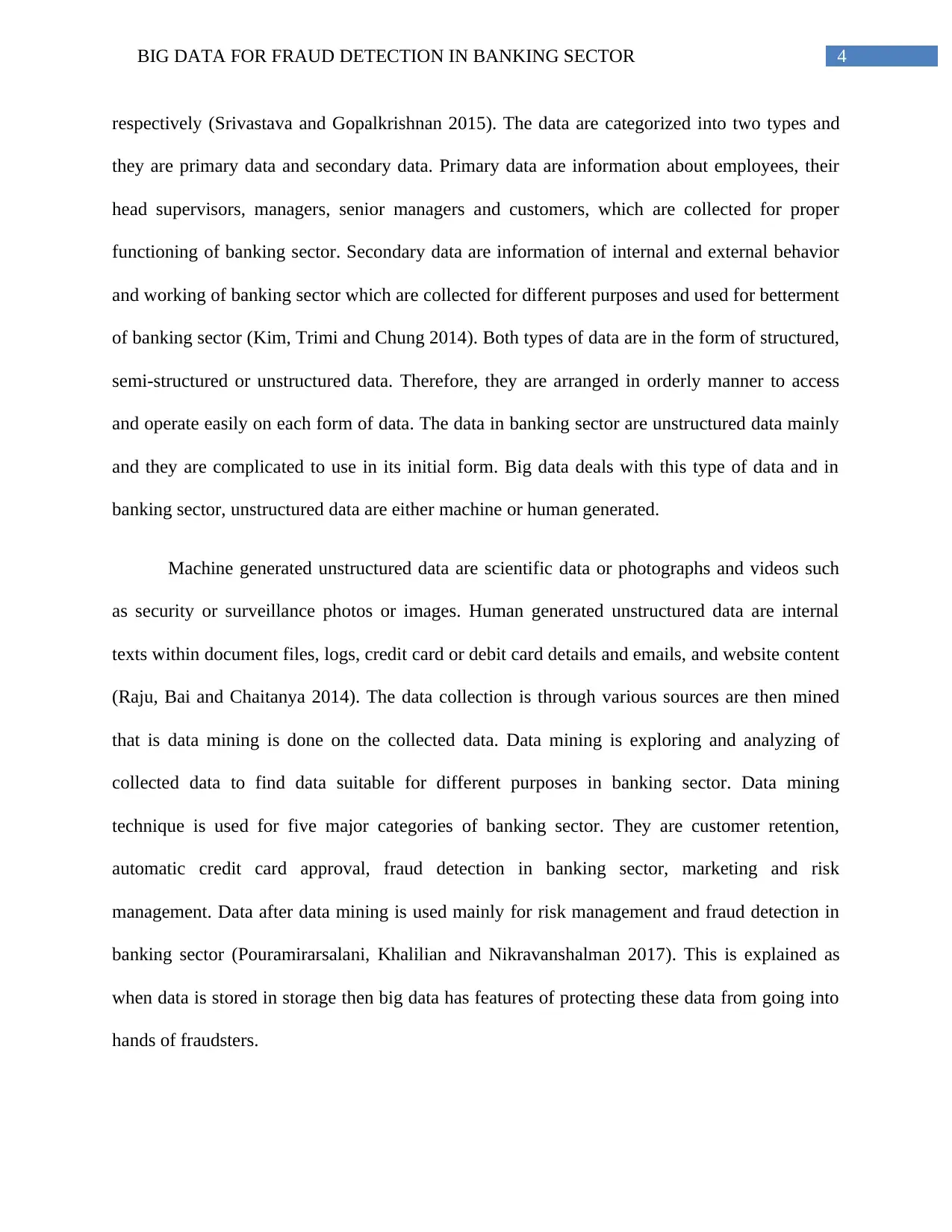
4BIG DATA FOR FRAUD DETECTION IN BANKING SECTOR
respectively (Srivastava and Gopalkrishnan 2015). The data are categorized into two types and
they are primary data and secondary data. Primary data are information about employees, their
head supervisors, managers, senior managers and customers, which are collected for proper
functioning of banking sector. Secondary data are information of internal and external behavior
and working of banking sector which are collected for different purposes and used for betterment
of banking sector (Kim, Trimi and Chung 2014). Both types of data are in the form of structured,
semi-structured or unstructured data. Therefore, they are arranged in orderly manner to access
and operate easily on each form of data. The data in banking sector are unstructured data mainly
and they are complicated to use in its initial form. Big data deals with this type of data and in
banking sector, unstructured data are either machine or human generated.
Machine generated unstructured data are scientific data or photographs and videos such
as security or surveillance photos or images. Human generated unstructured data are internal
texts within document files, logs, credit card or debit card details and emails, and website content
(Raju, Bai and Chaitanya 2014). The data collection is through various sources are then mined
that is data mining is done on the collected data. Data mining is exploring and analyzing of
collected data to find data suitable for different purposes in banking sector. Data mining
technique is used for five major categories of banking sector. They are customer retention,
automatic credit card approval, fraud detection in banking sector, marketing and risk
management. Data after data mining is used mainly for risk management and fraud detection in
banking sector (Pouramirarsalani, Khalilian and Nikravanshalman 2017). This is explained as
when data is stored in storage then big data has features of protecting these data from going into
hands of fraudsters.
respectively (Srivastava and Gopalkrishnan 2015). The data are categorized into two types and
they are primary data and secondary data. Primary data are information about employees, their
head supervisors, managers, senior managers and customers, which are collected for proper
functioning of banking sector. Secondary data are information of internal and external behavior
and working of banking sector which are collected for different purposes and used for betterment
of banking sector (Kim, Trimi and Chung 2014). Both types of data are in the form of structured,
semi-structured or unstructured data. Therefore, they are arranged in orderly manner to access
and operate easily on each form of data. The data in banking sector are unstructured data mainly
and they are complicated to use in its initial form. Big data deals with this type of data and in
banking sector, unstructured data are either machine or human generated.
Machine generated unstructured data are scientific data or photographs and videos such
as security or surveillance photos or images. Human generated unstructured data are internal
texts within document files, logs, credit card or debit card details and emails, and website content
(Raju, Bai and Chaitanya 2014). The data collection is through various sources are then mined
that is data mining is done on the collected data. Data mining is exploring and analyzing of
collected data to find data suitable for different purposes in banking sector. Data mining
technique is used for five major categories of banking sector. They are customer retention,
automatic credit card approval, fraud detection in banking sector, marketing and risk
management. Data after data mining is used mainly for risk management and fraud detection in
banking sector (Pouramirarsalani, Khalilian and Nikravanshalman 2017). This is explained as
when data is stored in storage then big data has features of protecting these data from going into
hands of fraudsters.
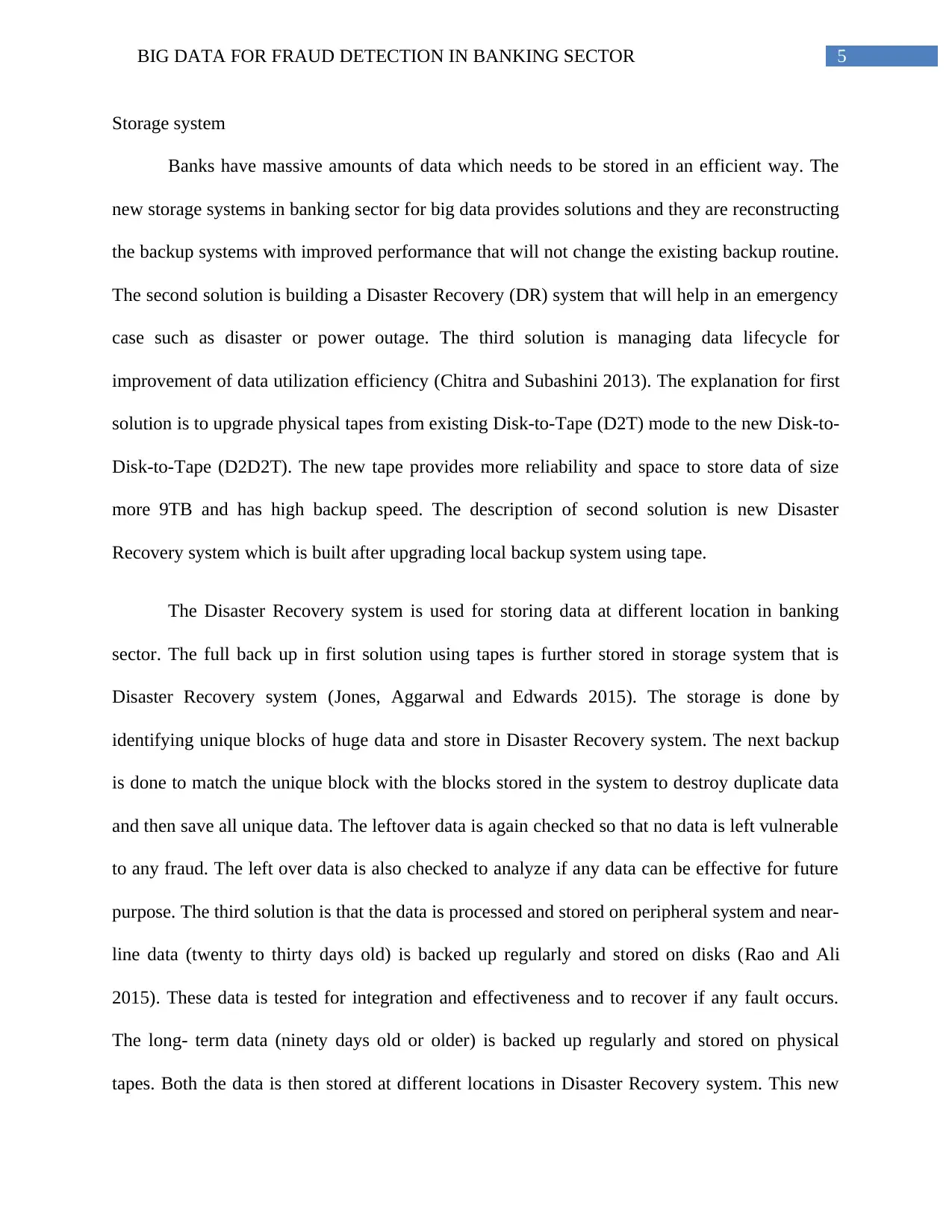
5BIG DATA FOR FRAUD DETECTION IN BANKING SECTOR
Storage system
Banks have massive amounts of data which needs to be stored in an efficient way. The
new storage systems in banking sector for big data provides solutions and they are reconstructing
the backup systems with improved performance that will not change the existing backup routine.
The second solution is building a Disaster Recovery (DR) system that will help in an emergency
case such as disaster or power outage. The third solution is managing data lifecycle for
improvement of data utilization efficiency (Chitra and Subashini 2013). The explanation for first
solution is to upgrade physical tapes from existing Disk-to-Tape (D2T) mode to the new Disk-to-
Disk-to-Tape (D2D2T). The new tape provides more reliability and space to store data of size
more 9TB and has high backup speed. The description of second solution is new Disaster
Recovery system which is built after upgrading local backup system using tape.
The Disaster Recovery system is used for storing data at different location in banking
sector. The full back up in first solution using tapes is further stored in storage system that is
Disaster Recovery system (Jones, Aggarwal and Edwards 2015). The storage is done by
identifying unique blocks of huge data and store in Disaster Recovery system. The next backup
is done to match the unique block with the blocks stored in the system to destroy duplicate data
and then save all unique data. The leftover data is again checked so that no data is left vulnerable
to any fraud. The left over data is also checked to analyze if any data can be effective for future
purpose. The third solution is that the data is processed and stored on peripheral system and near-
line data (twenty to thirty days old) is backed up regularly and stored on disks (Rao and Ali
2015). These data is tested for integration and effectiveness and to recover if any fault occurs.
The long- term data (ninety days old or older) is backed up regularly and stored on physical
tapes. Both the data is then stored at different locations in Disaster Recovery system. This new
Storage system
Banks have massive amounts of data which needs to be stored in an efficient way. The
new storage systems in banking sector for big data provides solutions and they are reconstructing
the backup systems with improved performance that will not change the existing backup routine.
The second solution is building a Disaster Recovery (DR) system that will help in an emergency
case such as disaster or power outage. The third solution is managing data lifecycle for
improvement of data utilization efficiency (Chitra and Subashini 2013). The explanation for first
solution is to upgrade physical tapes from existing Disk-to-Tape (D2T) mode to the new Disk-to-
Disk-to-Tape (D2D2T). The new tape provides more reliability and space to store data of size
more 9TB and has high backup speed. The description of second solution is new Disaster
Recovery system which is built after upgrading local backup system using tape.
The Disaster Recovery system is used for storing data at different location in banking
sector. The full back up in first solution using tapes is further stored in storage system that is
Disaster Recovery system (Jones, Aggarwal and Edwards 2015). The storage is done by
identifying unique blocks of huge data and store in Disaster Recovery system. The next backup
is done to match the unique block with the blocks stored in the system to destroy duplicate data
and then save all unique data. The leftover data is again checked so that no data is left vulnerable
to any fraud. The left over data is also checked to analyze if any data can be effective for future
purpose. The third solution is that the data is processed and stored on peripheral system and near-
line data (twenty to thirty days old) is backed up regularly and stored on disks (Rao and Ali
2015). These data is tested for integration and effectiveness and to recover if any fault occurs.
The long- term data (ninety days old or older) is backed up regularly and stored on physical
tapes. Both the data is then stored at different locations in Disaster Recovery system. This new
⊘ This is a preview!⊘
Do you want full access?
Subscribe today to unlock all pages.

Trusted by 1+ million students worldwide
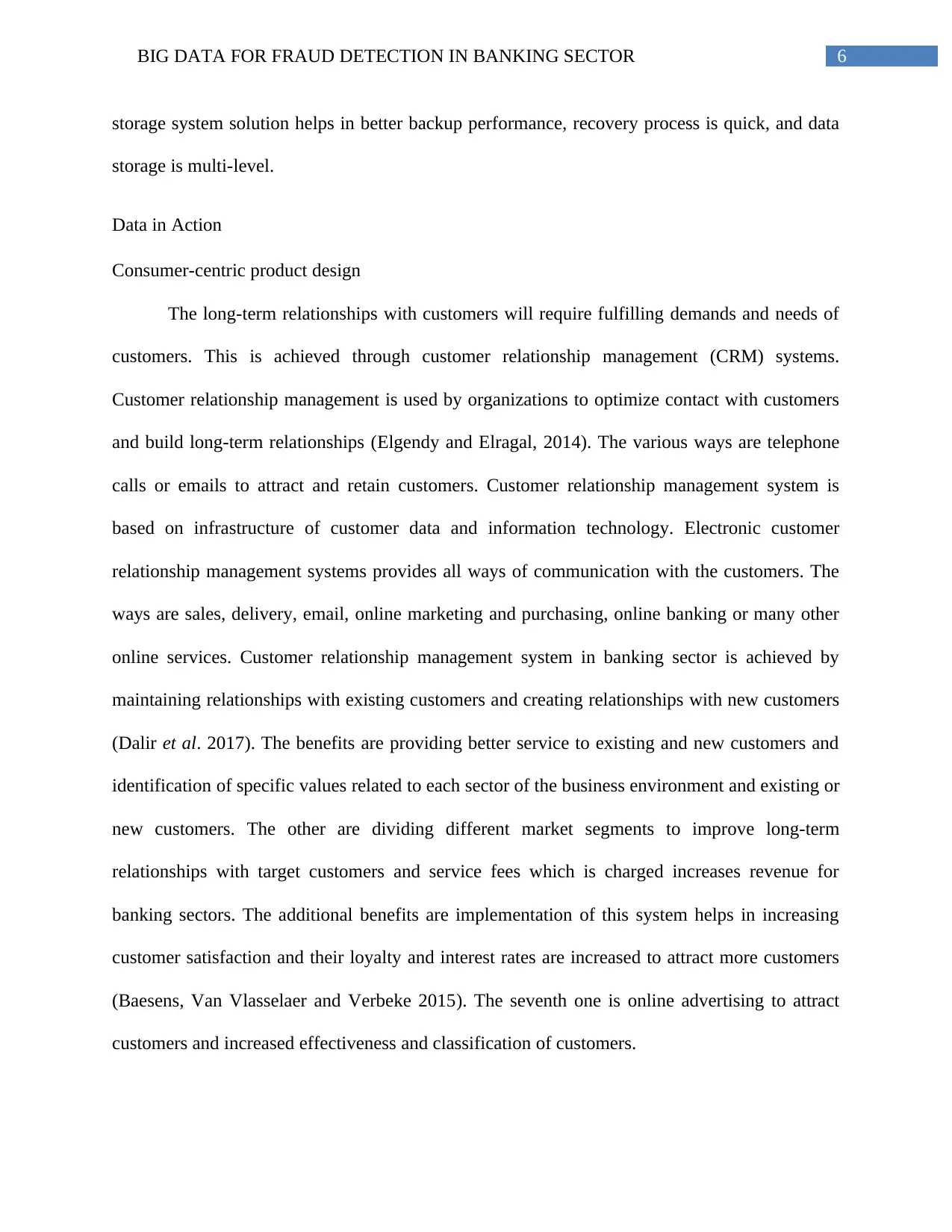
6BIG DATA FOR FRAUD DETECTION IN BANKING SECTOR
storage system solution helps in better backup performance, recovery process is quick, and data
storage is multi-level.
Data in Action
Consumer-centric product design
The long-term relationships with customers will require fulfilling demands and needs of
customers. This is achieved through customer relationship management (CRM) systems.
Customer relationship management is used by organizations to optimize contact with customers
and build long-term relationships (Elgendy and Elragal, 2014). The various ways are telephone
calls or emails to attract and retain customers. Customer relationship management system is
based on infrastructure of customer data and information technology. Electronic customer
relationship management systems provides all ways of communication with the customers. The
ways are sales, delivery, email, online marketing and purchasing, online banking or many other
online services. Customer relationship management system in banking sector is achieved by
maintaining relationships with existing customers and creating relationships with new customers
(Dalir et al. 2017). The benefits are providing better service to existing and new customers and
identification of specific values related to each sector of the business environment and existing or
new customers. The other are dividing different market segments to improve long-term
relationships with target customers and service fees which is charged increases revenue for
banking sectors. The additional benefits are implementation of this system helps in increasing
customer satisfaction and their loyalty and interest rates are increased to attract more customers
(Baesens, Van Vlasselaer and Verbeke 2015). The seventh one is online advertising to attract
customers and increased effectiveness and classification of customers.
storage system solution helps in better backup performance, recovery process is quick, and data
storage is multi-level.
Data in Action
Consumer-centric product design
The long-term relationships with customers will require fulfilling demands and needs of
customers. This is achieved through customer relationship management (CRM) systems.
Customer relationship management is used by organizations to optimize contact with customers
and build long-term relationships (Elgendy and Elragal, 2014). The various ways are telephone
calls or emails to attract and retain customers. Customer relationship management system is
based on infrastructure of customer data and information technology. Electronic customer
relationship management systems provides all ways of communication with the customers. The
ways are sales, delivery, email, online marketing and purchasing, online banking or many other
online services. Customer relationship management system in banking sector is achieved by
maintaining relationships with existing customers and creating relationships with new customers
(Dalir et al. 2017). The benefits are providing better service to existing and new customers and
identification of specific values related to each sector of the business environment and existing or
new customers. The other are dividing different market segments to improve long-term
relationships with target customers and service fees which is charged increases revenue for
banking sectors. The additional benefits are implementation of this system helps in increasing
customer satisfaction and their loyalty and interest rates are increased to attract more customers
(Baesens, Van Vlasselaer and Verbeke 2015). The seventh one is online advertising to attract
customers and increased effectiveness and classification of customers.
Paraphrase This Document
Need a fresh take? Get an instant paraphrase of this document with our AI Paraphraser
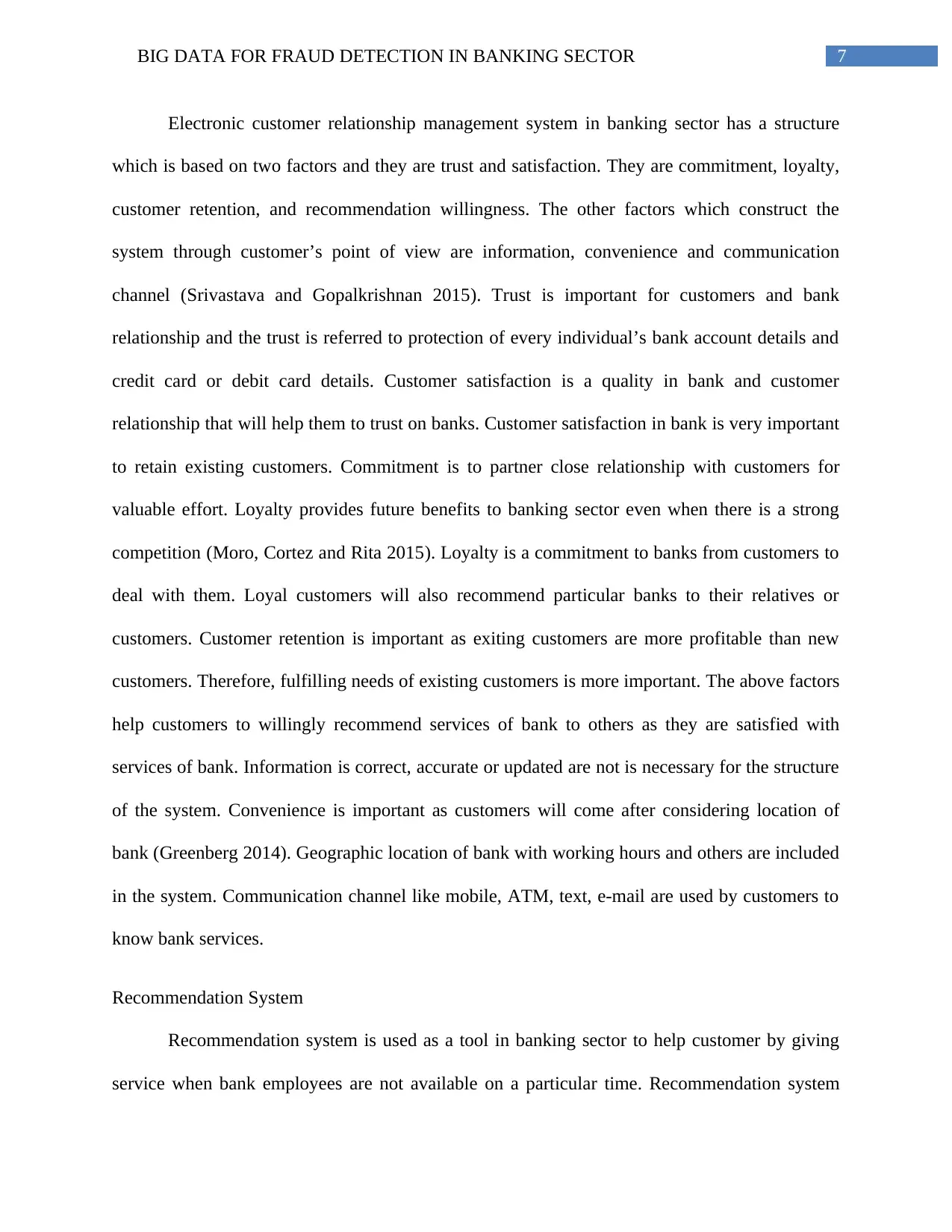
7BIG DATA FOR FRAUD DETECTION IN BANKING SECTOR
Electronic customer relationship management system in banking sector has a structure
which is based on two factors and they are trust and satisfaction. They are commitment, loyalty,
customer retention, and recommendation willingness. The other factors which construct the
system through customer’s point of view are information, convenience and communication
channel (Srivastava and Gopalkrishnan 2015). Trust is important for customers and bank
relationship and the trust is referred to protection of every individual’s bank account details and
credit card or debit card details. Customer satisfaction is a quality in bank and customer
relationship that will help them to trust on banks. Customer satisfaction in bank is very important
to retain existing customers. Commitment is to partner close relationship with customers for
valuable effort. Loyalty provides future benefits to banking sector even when there is a strong
competition (Moro, Cortez and Rita 2015). Loyalty is a commitment to banks from customers to
deal with them. Loyal customers will also recommend particular banks to their relatives or
customers. Customer retention is important as exiting customers are more profitable than new
customers. Therefore, fulfilling needs of existing customers is more important. The above factors
help customers to willingly recommend services of bank to others as they are satisfied with
services of bank. Information is correct, accurate or updated are not is necessary for the structure
of the system. Convenience is important as customers will come after considering location of
bank (Greenberg 2014). Geographic location of bank with working hours and others are included
in the system. Communication channel like mobile, ATM, text, e-mail are used by customers to
know bank services.
Recommendation System
Recommendation system is used as a tool in banking sector to help customer by giving
service when bank employees are not available on a particular time. Recommendation system
Electronic customer relationship management system in banking sector has a structure
which is based on two factors and they are trust and satisfaction. They are commitment, loyalty,
customer retention, and recommendation willingness. The other factors which construct the
system through customer’s point of view are information, convenience and communication
channel (Srivastava and Gopalkrishnan 2015). Trust is important for customers and bank
relationship and the trust is referred to protection of every individual’s bank account details and
credit card or debit card details. Customer satisfaction is a quality in bank and customer
relationship that will help them to trust on banks. Customer satisfaction in bank is very important
to retain existing customers. Commitment is to partner close relationship with customers for
valuable effort. Loyalty provides future benefits to banking sector even when there is a strong
competition (Moro, Cortez and Rita 2015). Loyalty is a commitment to banks from customers to
deal with them. Loyal customers will also recommend particular banks to their relatives or
customers. Customer retention is important as exiting customers are more profitable than new
customers. Therefore, fulfilling needs of existing customers is more important. The above factors
help customers to willingly recommend services of bank to others as they are satisfied with
services of bank. Information is correct, accurate or updated are not is necessary for the structure
of the system. Convenience is important as customers will come after considering location of
bank (Greenberg 2014). Geographic location of bank with working hours and others are included
in the system. Communication channel like mobile, ATM, text, e-mail are used by customers to
know bank services.
Recommendation System
Recommendation system is used as a tool in banking sector to help customer by giving
service when bank employees are not available on a particular time. Recommendation system
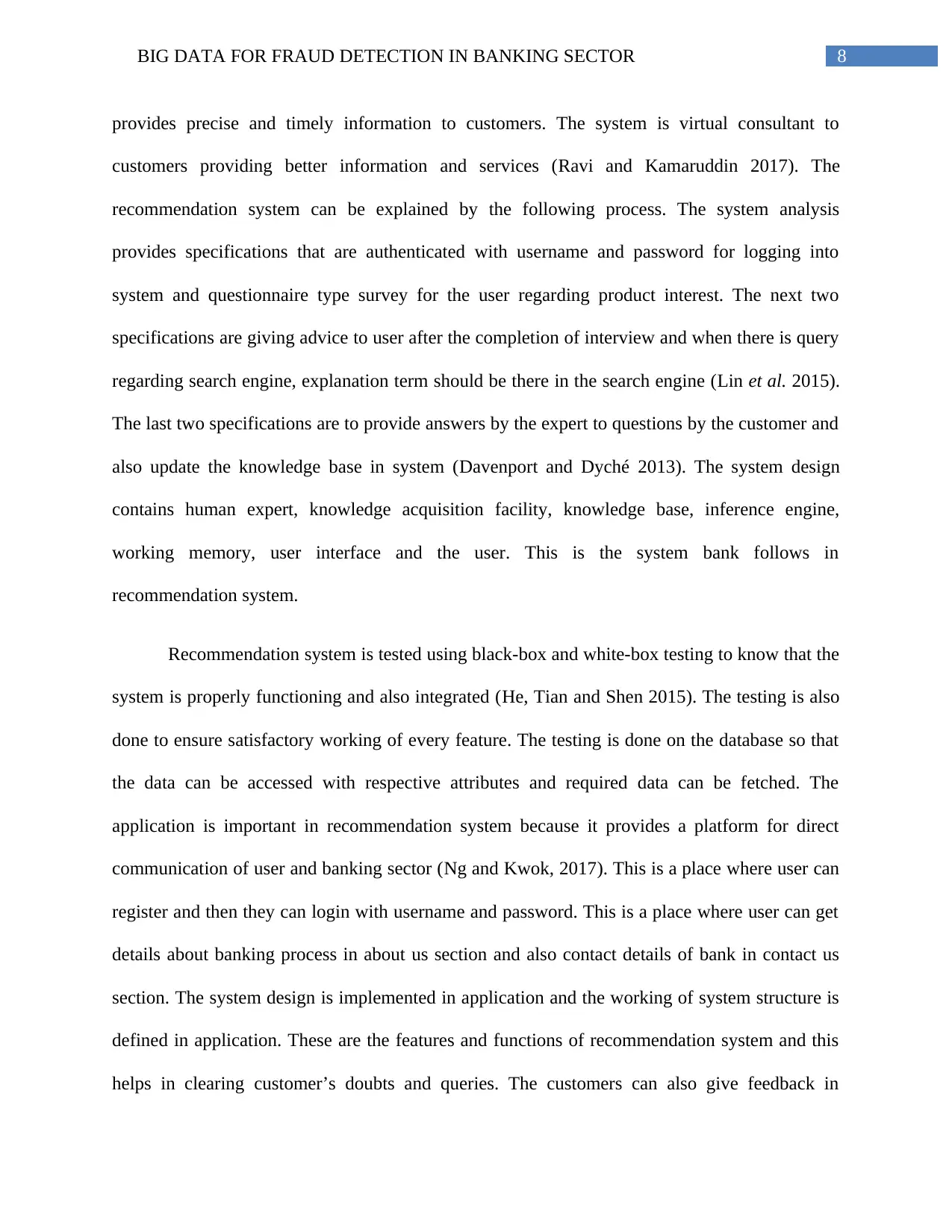
8BIG DATA FOR FRAUD DETECTION IN BANKING SECTOR
provides precise and timely information to customers. The system is virtual consultant to
customers providing better information and services (Ravi and Kamaruddin 2017). The
recommendation system can be explained by the following process. The system analysis
provides specifications that are authenticated with username and password for logging into
system and questionnaire type survey for the user regarding product interest. The next two
specifications are giving advice to user after the completion of interview and when there is query
regarding search engine, explanation term should be there in the search engine (Lin et al. 2015).
The last two specifications are to provide answers by the expert to questions by the customer and
also update the knowledge base in system (Davenport and Dyché 2013). The system design
contains human expert, knowledge acquisition facility, knowledge base, inference engine,
working memory, user interface and the user. This is the system bank follows in
recommendation system.
Recommendation system is tested using black-box and white-box testing to know that the
system is properly functioning and also integrated (He, Tian and Shen 2015). The testing is also
done to ensure satisfactory working of every feature. The testing is done on the database so that
the data can be accessed with respective attributes and required data can be fetched. The
application is important in recommendation system because it provides a platform for direct
communication of user and banking sector (Ng and Kwok, 2017). This is a place where user can
register and then they can login with username and password. This is a place where user can get
details about banking process in about us section and also contact details of bank in contact us
section. The system design is implemented in application and the working of system structure is
defined in application. These are the features and functions of recommendation system and this
helps in clearing customer’s doubts and queries. The customers can also give feedback in
provides precise and timely information to customers. The system is virtual consultant to
customers providing better information and services (Ravi and Kamaruddin 2017). The
recommendation system can be explained by the following process. The system analysis
provides specifications that are authenticated with username and password for logging into
system and questionnaire type survey for the user regarding product interest. The next two
specifications are giving advice to user after the completion of interview and when there is query
regarding search engine, explanation term should be there in the search engine (Lin et al. 2015).
The last two specifications are to provide answers by the expert to questions by the customer and
also update the knowledge base in system (Davenport and Dyché 2013). The system design
contains human expert, knowledge acquisition facility, knowledge base, inference engine,
working memory, user interface and the user. This is the system bank follows in
recommendation system.
Recommendation system is tested using black-box and white-box testing to know that the
system is properly functioning and also integrated (He, Tian and Shen 2015). The testing is also
done to ensure satisfactory working of every feature. The testing is done on the database so that
the data can be accessed with respective attributes and required data can be fetched. The
application is important in recommendation system because it provides a platform for direct
communication of user and banking sector (Ng and Kwok, 2017). This is a place where user can
register and then they can login with username and password. This is a place where user can get
details about banking process in about us section and also contact details of bank in contact us
section. The system design is implemented in application and the working of system structure is
defined in application. These are the features and functions of recommendation system and this
helps in clearing customer’s doubts and queries. The customers can also give feedback in
⊘ This is a preview!⊘
Do you want full access?
Subscribe today to unlock all pages.

Trusted by 1+ million students worldwide
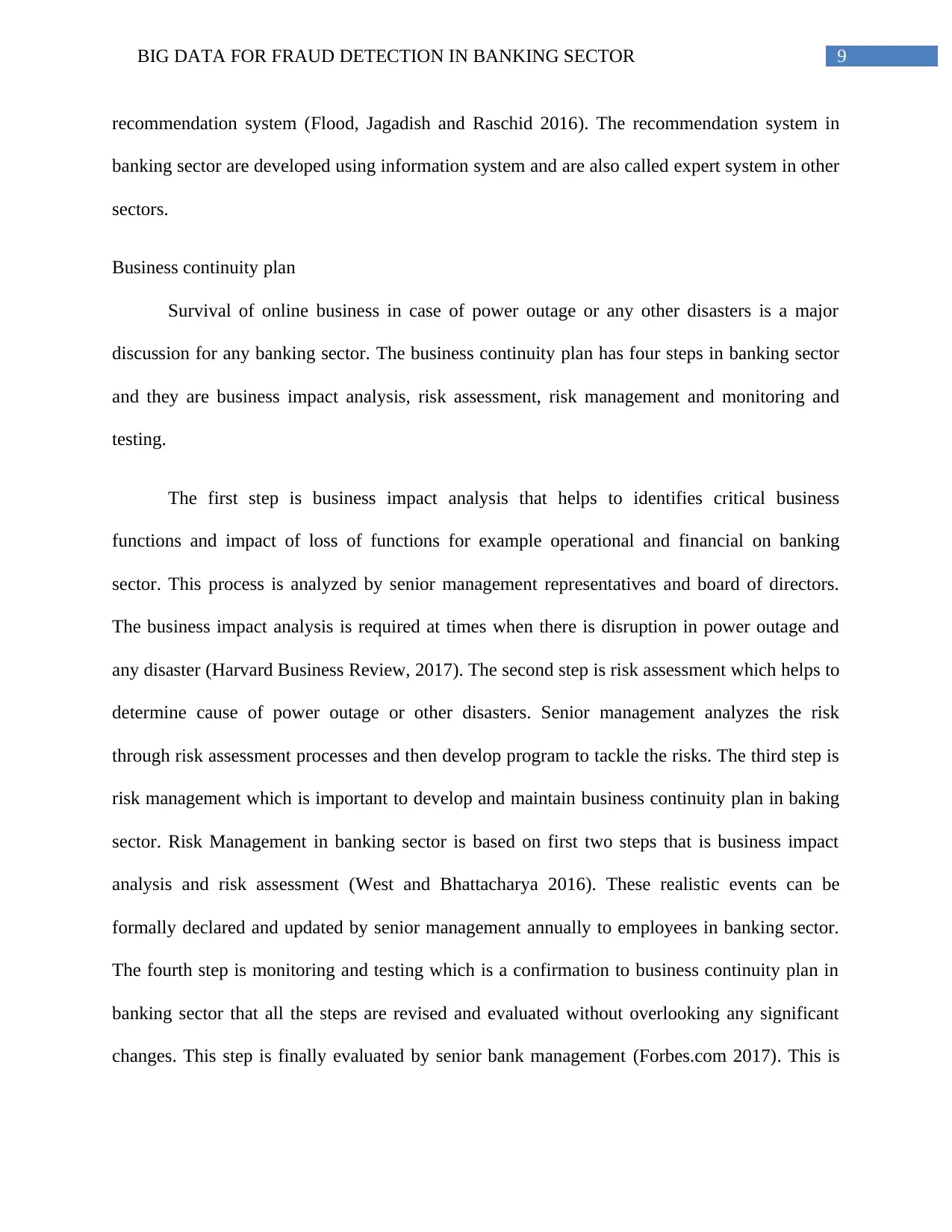
9BIG DATA FOR FRAUD DETECTION IN BANKING SECTOR
recommendation system (Flood, Jagadish and Raschid 2016). The recommendation system in
banking sector are developed using information system and are also called expert system in other
sectors.
Business continuity plan
Survival of online business in case of power outage or any other disasters is a major
discussion for any banking sector. The business continuity plan has four steps in banking sector
and they are business impact analysis, risk assessment, risk management and monitoring and
testing.
The first step is business impact analysis that helps to identifies critical business
functions and impact of loss of functions for example operational and financial on banking
sector. This process is analyzed by senior management representatives and board of directors.
The business impact analysis is required at times when there is disruption in power outage and
any disaster (Harvard Business Review, 2017). The second step is risk assessment which helps to
determine cause of power outage or other disasters. Senior management analyzes the risk
through risk assessment processes and then develop program to tackle the risks. The third step is
risk management which is important to develop and maintain business continuity plan in baking
sector. Risk Management in banking sector is based on first two steps that is business impact
analysis and risk assessment (West and Bhattacharya 2016). These realistic events can be
formally declared and updated by senior management annually to employees in banking sector.
The fourth step is monitoring and testing which is a confirmation to business continuity plan in
banking sector that all the steps are revised and evaluated without overlooking any significant
changes. This step is finally evaluated by senior bank management (Forbes.com 2017). This is
recommendation system (Flood, Jagadish and Raschid 2016). The recommendation system in
banking sector are developed using information system and are also called expert system in other
sectors.
Business continuity plan
Survival of online business in case of power outage or any other disasters is a major
discussion for any banking sector. The business continuity plan has four steps in banking sector
and they are business impact analysis, risk assessment, risk management and monitoring and
testing.
The first step is business impact analysis that helps to identifies critical business
functions and impact of loss of functions for example operational and financial on banking
sector. This process is analyzed by senior management representatives and board of directors.
The business impact analysis is required at times when there is disruption in power outage and
any disaster (Harvard Business Review, 2017). The second step is risk assessment which helps to
determine cause of power outage or other disasters. Senior management analyzes the risk
through risk assessment processes and then develop program to tackle the risks. The third step is
risk management which is important to develop and maintain business continuity plan in baking
sector. Risk Management in banking sector is based on first two steps that is business impact
analysis and risk assessment (West and Bhattacharya 2016). These realistic events can be
formally declared and updated by senior management annually to employees in banking sector.
The fourth step is monitoring and testing which is a confirmation to business continuity plan in
banking sector that all the steps are revised and evaluated without overlooking any significant
changes. This step is finally evaluated by senior bank management (Forbes.com 2017). This is
Paraphrase This Document
Need a fresh take? Get an instant paraphrase of this document with our AI Paraphraser
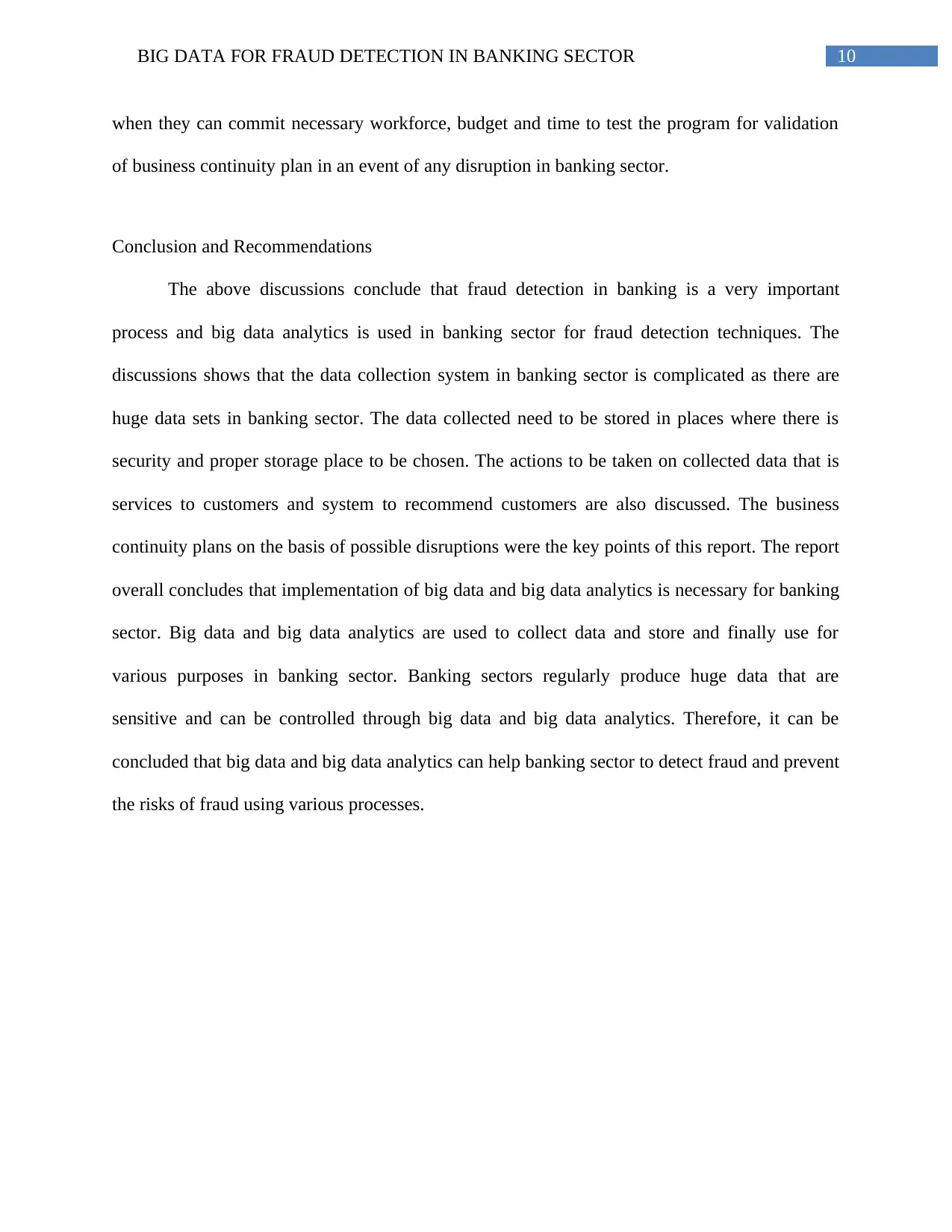
10BIG DATA FOR FRAUD DETECTION IN BANKING SECTOR
when they can commit necessary workforce, budget and time to test the program for validation
of business continuity plan in an event of any disruption in banking sector.
Conclusion and Recommendations
The above discussions conclude that fraud detection in banking is a very important
process and big data analytics is used in banking sector for fraud detection techniques. The
discussions shows that the data collection system in banking sector is complicated as there are
huge data sets in banking sector. The data collected need to be stored in places where there is
security and proper storage place to be chosen. The actions to be taken on collected data that is
services to customers and system to recommend customers are also discussed. The business
continuity plans on the basis of possible disruptions were the key points of this report. The report
overall concludes that implementation of big data and big data analytics is necessary for banking
sector. Big data and big data analytics are used to collect data and store and finally use for
various purposes in banking sector. Banking sectors regularly produce huge data that are
sensitive and can be controlled through big data and big data analytics. Therefore, it can be
concluded that big data and big data analytics can help banking sector to detect fraud and prevent
the risks of fraud using various processes.
when they can commit necessary workforce, budget and time to test the program for validation
of business continuity plan in an event of any disruption in banking sector.
Conclusion and Recommendations
The above discussions conclude that fraud detection in banking is a very important
process and big data analytics is used in banking sector for fraud detection techniques. The
discussions shows that the data collection system in banking sector is complicated as there are
huge data sets in banking sector. The data collected need to be stored in places where there is
security and proper storage place to be chosen. The actions to be taken on collected data that is
services to customers and system to recommend customers are also discussed. The business
continuity plans on the basis of possible disruptions were the key points of this report. The report
overall concludes that implementation of big data and big data analytics is necessary for banking
sector. Big data and big data analytics are used to collect data and store and finally use for
various purposes in banking sector. Banking sectors regularly produce huge data that are
sensitive and can be controlled through big data and big data analytics. Therefore, it can be
concluded that big data and big data analytics can help banking sector to detect fraud and prevent
the risks of fraud using various processes.
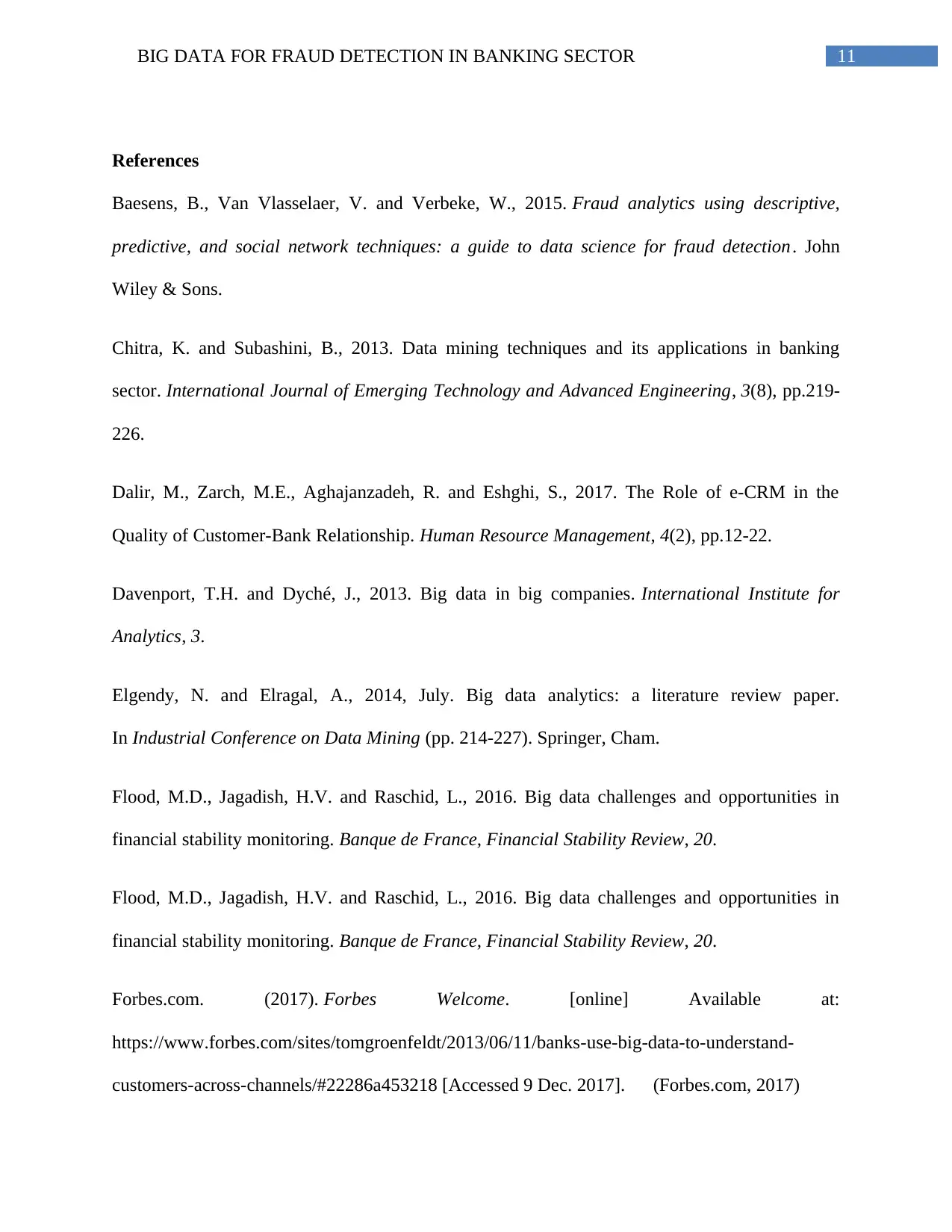
11BIG DATA FOR FRAUD DETECTION IN BANKING SECTOR
References
Baesens, B., Van Vlasselaer, V. and Verbeke, W., 2015. Fraud analytics using descriptive,
predictive, and social network techniques: a guide to data science for fraud detection. John
Wiley & Sons.
Chitra, K. and Subashini, B., 2013. Data mining techniques and its applications in banking
sector. International Journal of Emerging Technology and Advanced Engineering, 3(8), pp.219-
226.
Dalir, M., Zarch, M.E., Aghajanzadeh, R. and Eshghi, S., 2017. The Role of e-CRM in the
Quality of Customer-Bank Relationship. Human Resource Management, 4(2), pp.12-22.
Davenport, T.H. and Dyché, J., 2013. Big data in big companies. International Institute for
Analytics, 3.
Elgendy, N. and Elragal, A., 2014, July. Big data analytics: a literature review paper.
In Industrial Conference on Data Mining (pp. 214-227). Springer, Cham.
Flood, M.D., Jagadish, H.V. and Raschid, L., 2016. Big data challenges and opportunities in
financial stability monitoring. Banque de France, Financial Stability Review, 20.
Flood, M.D., Jagadish, H.V. and Raschid, L., 2016. Big data challenges and opportunities in
financial stability monitoring. Banque de France, Financial Stability Review, 20.
Forbes.com. (2017). Forbes Welcome. [online] Available at:
https://www.forbes.com/sites/tomgroenfeldt/2013/06/11/banks-use-big-data-to-understand-
customers-across-channels/#22286a453218 [Accessed 9 Dec. 2017]. (Forbes.com, 2017)
References
Baesens, B., Van Vlasselaer, V. and Verbeke, W., 2015. Fraud analytics using descriptive,
predictive, and social network techniques: a guide to data science for fraud detection. John
Wiley & Sons.
Chitra, K. and Subashini, B., 2013. Data mining techniques and its applications in banking
sector. International Journal of Emerging Technology and Advanced Engineering, 3(8), pp.219-
226.
Dalir, M., Zarch, M.E., Aghajanzadeh, R. and Eshghi, S., 2017. The Role of e-CRM in the
Quality of Customer-Bank Relationship. Human Resource Management, 4(2), pp.12-22.
Davenport, T.H. and Dyché, J., 2013. Big data in big companies. International Institute for
Analytics, 3.
Elgendy, N. and Elragal, A., 2014, July. Big data analytics: a literature review paper.
In Industrial Conference on Data Mining (pp. 214-227). Springer, Cham.
Flood, M.D., Jagadish, H.V. and Raschid, L., 2016. Big data challenges and opportunities in
financial stability monitoring. Banque de France, Financial Stability Review, 20.
Flood, M.D., Jagadish, H.V. and Raschid, L., 2016. Big data challenges and opportunities in
financial stability monitoring. Banque de France, Financial Stability Review, 20.
Forbes.com. (2017). Forbes Welcome. [online] Available at:
https://www.forbes.com/sites/tomgroenfeldt/2013/06/11/banks-use-big-data-to-understand-
customers-across-channels/#22286a453218 [Accessed 9 Dec. 2017]. (Forbes.com, 2017)
⊘ This is a preview!⊘
Do you want full access?
Subscribe today to unlock all pages.

Trusted by 1+ million students worldwide
1 out of 15
Related Documents
Your All-in-One AI-Powered Toolkit for Academic Success.
+13062052269
info@desklib.com
Available 24*7 on WhatsApp / Email
![[object Object]](/_next/static/media/star-bottom.7253800d.svg)
Unlock your academic potential
Copyright © 2020–2025 A2Z Services. All Rights Reserved. Developed and managed by ZUCOL.




